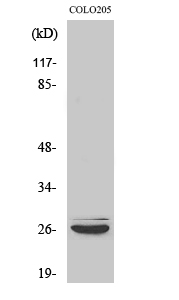Caspase-14 Polyclonal Antibody
- Catalog No.:YC0023
- Applications:WB;ELISA
- Reactivity:Human;Rat;Mouse;
- Target:
- Caspase-14
- Gene Name:
- CASP14
- Protein Name:
- Caspase14
- Human Gene Id:
- 23581
- Human Swiss Prot No:
- P31944
- Mouse Swiss Prot No:
- O89094
- Immunogen:
- Synthesized peptide derived from Caspase-14 . at AA range: 110-190
- Specificity:
- Caspase-14 Polyclonal Antibody detects endogenous levels of Caspase-14 protein.
- Formulation:
- Liquid in PBS containing 50% glycerol, 0.5% BSA and 0.02% sodium azide.
- Source:
- Polyclonal, Rabbit,IgG
- Dilution:
- WB 1:500 - 1:2000. ELISA: 1:40000. Not yet tested in other applications.
- Purification:
- The antibody was affinity-purified from rabbit antiserum by affinity-chromatography using epitope-specific immunogen.
- Concentration:
- 1 mg/ml
- Storage Stability:
- -15°C to -25°C/1 year(Do not lower than -25°C)
- Other Name:
- CASP14;Caspase-14;CASP-14
- Observed Band(KD):
- 27kD
- Background:
- This gene encodes a member of the cysteine-aspartic acid protease (caspase) family. Sequential activation of caspases plays a central role in the execution-phase of cell apoptosis. Caspases exist as inactive proenzymes which undergo proteolytic processing at conserved aspartic residues to produce two subunits, large and small, that dimerize to form the active enzyme. This caspase has been shown to be processed and activated by caspase 8 and caspase 10 in vitro, and by anti-Fas agonist antibody or TNF-related apoptosis inducing ligand in vivo. The expression and processing of this caspase may be involved in keratinocyte terminal differentiation, which is important for the formation of the skin barrier. [provided by RefSeq, Jul 2008],
- Function:
- function:Believed to be a non-apoptotic caspase which is involved in epidermal differentiation. Seems to play a role in keratinocyte differentiation and cornification. Probably regulates maturation of the epidermis by proteolytically processing filaggrin.,induction:In undifferentiated keratinocytes under postconfluency growth conditions (in vitro).,similarity:Belongs to the peptidase C14A family.,subunit:Complex of unprocessed caspase-14 and processed 19 kDa (p19) and 10 kDa (p10) subunits.,tissue specificity:Expressed in kerotinocytes of adult skin suprabasal layers (from spinous layers to the stratum granulosum and stratum corneum) (at protein level). Expressed in keratinocytes of hair shaft and sebaceous glands (at protein level). In psoriatic skin only expressed at very low levels.,
- Subcellular Location:
- Cytoplasm . Nucleus .
- Expression:
- Expressed in keratinocytes of adult skin suprabasal layers (from spinous layers to the stratum granulosum and stratum corneum) (at protein level). Expressed in keratinocytes of hair shaft and sebaceous glands (at protein level). In psoriatic skin only expressed at very low levels (PubMed:11175259). The p17/10 mature form is expressed in epidermis stratum corneum, the p20/p8 intermediate form in epidermis upper granular cells of the stratum granulosum (PubMed:22825846).
- June 19-2018
- WESTERN IMMUNOBLOTTING PROTOCOL
- June 19-2018
- IMMUNOHISTOCHEMISTRY-PARAFFIN PROTOCOL
- June 19-2018
- IMMUNOFLUORESCENCE PROTOCOL
- September 08-2020
- FLOW-CYTOMEYRT-PROTOCOL
- May 20-2022
- Cell-Based ELISA│解您多样本WB检测之困扰
- July 13-2018
- CELL-BASED-ELISA-PROTOCOL-FOR-ACETYL-PROTEIN
- July 13-2018
- CELL-BASED-ELISA-PROTOCOL-FOR-PHOSPHO-PROTEIN
- July 13-2018
- Antibody-FAQs
- Products Images

- Western Blot analysis of various cells using Caspase-14 Polyclonal Antibody



